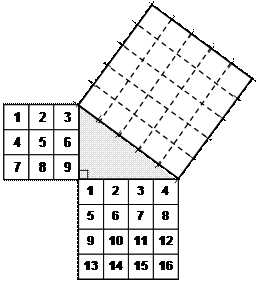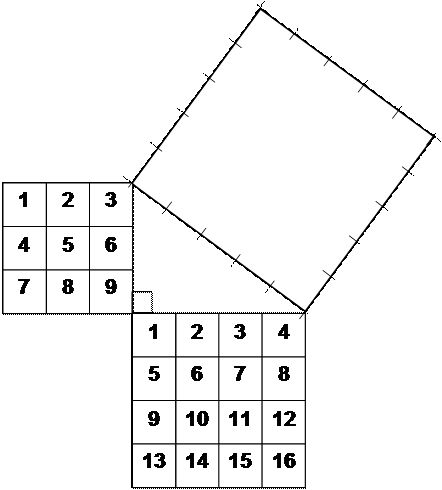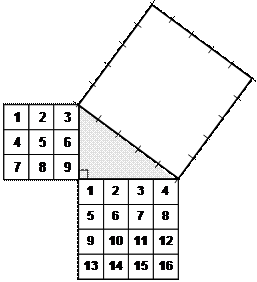Discovering the Pythagorean Theorem
TEKS 8.7c The student uses geometry to model and describe the physical world.
The student is expected to use pictures or models to demonstrate the Pythagorean Theorem.
Objective: The learner will use centimeter cubes, tiles, or cut-apart grids to represent the relationship between areas of squares formed by the legs and hypotenuse of a right triangle, thus demonstrating the Pythagorean Theorem.
Materials: Student activity sheet “Discovering the Pythagorean Theorem”
square units (cm cubes, square tiles, or cm grid paper) – 225 or more per group
Scissors - 1 per student
Tape – 1 per group
Cm grid paper – ½ sheet per group
Notebook paper or scratch paper (a couple per group) for taping down triangles
Transparencies for follow-up discussion
Student worksheet “Modeling the Pythagorean Theorem”
Vocabulary: right triangle, legs, hypotenuse, area (esp. of a square), square unit
Procedure: Arrange students into groups of 4 students each.
Give each student a copy of the “Discovering the Pythagorean Theorem” activity sheet. Give the students enough time to complete steps 1-6 on the handout. Ask students to share their observations. You will want to make sure that they include in their observations the following key ideas:
Use the space below to write additional observations you want to watch for or specify ways your team will set-up and introduce this activity.
Additional notes:
Have students continue with the activity in their group. They will need up to 225 unit manipulatives in order to do the last triangle given on the chart for #7. If you don’t have enough units for each group, tell them to shade the squares on grid paper to represent the tiles and see if they can use the pattern from the previous triples of squares built to determine how many units are needed for the last square in the 12-9-? triple. Monitor the students work as they build their squares. Make sure they have come up with the correct equation for #8 before proceeding to #9. Their equation should be ![]() .
.
When students are taping their triangles for #10, make sure they butt the corners together instead of overlapping. Overlapping corners will prevent them from getting a right triangle, which is the main concept that we want them to observe at this point. Allow some time for each group to share what they observed about the triangles. This would also be a good time to connect the requirement for having a right triangle in order for the Pythagorean Theorem to work. A counter example will be shown in the next part of this lesson.
Use the space below for additional team discussion. You may want to introduce right triangle vocabulary at this time.
Additional notes:
 After groups have shared their observations, use Transparencies 1 and 2 to further develop the Pythagorean Theorem. This will probably be at the start of Day 2. The transparencies match up with problems 1 and 2 on the worksheet “Modeling the Pythagorean Theorem”. Possible answers to the questions on the worksheet are shown below.
After groups have shared their observations, use Transparencies 1 and 2 to further develop the Pythagorean Theorem. This will probably be at the start of Day 2. The transparencies match up with problems 1 and 2 on the worksheet “Modeling the Pythagorean Theorem”. Possible answers to the questions on the worksheet are shown below.
1. Consider the triangle with attached squares shown.
(See transparency and student worksheet)
How many numbered squares will it take to fill
the large square? 25 squares
We can also refer to the numbered squares
as unit squares.
Use the tick marks along the sides of the
large square to check the number of
unit squares that fit.
- Students can draw lines to form the unit
square inside the large square and number them.
How is this problem like the squares you built in the “Discovering the Pythagorean Theorem” activity?
- All of the triangles are right triangles.
- In every triangle, the squares attached to the legs have the same total number of
units than the square attached to the hypotenuse.
 2. Now consider this triangle. How many unit squares are required to fill the large square? Based on what we’ve been doing, it would take a total of 13 squares.
2. Now consider this triangle. How many unit squares are required to fill the large square? Based on what we’ve been doing, it would take a total of 13 squares.
Draw in the unit squares on the large square.
Was your answer correct? Why or why not?
It actually takes 16 squares because the large
square has a side length of 4.
How is this problem different from problem 1 and the problems in the “Discovering the Pythagorean Theorem” activity?
The triangle in the middle is not a right
triangle so the patterns that we used before don’t work.
What has to be true for the sums of the areas of the smaller squares
To equal the area of the larger square? The triangle has to be a right triangle.
Use the space below for additional team discussion.
Additional notes:
Discovering the Pythagorean Theorem Name__________________________
Activity Sheet
Instructions:
1. In your group, use the units provided by your teacher to build a 3´3 square on your desk.
![]()
2. Set your 3´3 square aside and build a 4´4 square on your desk.

3. Now combine ALL of the units from your two squares.

How many units do you have altogether? ______
4. Make a square from these units. What size square can you make? _____________
Draw your square here:
5. Organize your numbers in the chart below.
1st square |
2nd square |
3rd Square |
|||
Number of units ( ) |
Length of side (a) |
Number of units ( ) |
Length of side (b) |
Number of units ( ) |
Length of side (c) |
|
|
|
|
|
|
6. Write down everything your group observes about each of the following:
build the square.
Stop here and be ready to share your observations with the class.
Activity Sheet (continued)
7. Repeat the square building process with squares whose side lengths are given in the chart below. In each case, build the first two squares, then use the combined units to make the 3rd square. Fill in the chart as you build each triple of squares.
1st square |
2nd square |
3rd Square |
Total Number of Units |
|||
Number of units (a2) |
Length of side (a) |
Number of units (b2) |
Length of side (b) |
Number of units (c2) |
Length of side (c) |
|
9 |
3 |
16 |
4 |
25 |
5 |
9 + 16 = 25 |
|
5 |
|
12 |
|
|
|
|
6 |
|
8 |
|
|
|
|
12 |
|
9 |
|
|
|
|
|
|
|
|
|
|
8. Using the letters a, b, and c for the lengths of the sides of the three squares, write an equation that shows the total number of units used to build the squares.
The equation you wrote for #8 is a special formula called the Pythagorean Theorem. You will learn more about Pythagoras, the man who invented the formula, at a later time. Right now you will learn what the Pythagorean Theorem formula is used for.
9. Use centimeter grid paper to cut out strips of paper that match the side lengths of the squares you built earlier. This means you will need strips of the following lengths:
3, 4 and 5 5, 12 and 13 6, 8 and 10 12, 9 and 15
10. Each set of strips will form a triangle. Use tape to connect the strips together without overlapping the strips (see example below). Tape your triangles to a sheet of notebook paper.
Write what you observe about the triangles you made. Explain what the letters a, b, and c could describe in your triangles.
What do you notice about all of the triangles?

Stop here and be ready to share your observations with the class.
Transparency 1
 1. Consider the triangle with attached squares shown. How many numbered squares will it take to fill the large square?
1. Consider the triangle with attached squares shown. How many numbered squares will it take to fill the large square?
We can also refer to the numbered squares as unit squares. Use the tick marks along the sides of the large square to check the number of unit squares that fit.
How is this problem like the squares you built in the “Discovering the Pythagorean Theorem” activity?
Transparency 2
 2. Now consider this triangle. How many unit squares are required to fill the large square?
2. Now consider this triangle. How many unit squares are required to fill the large square?
Draw in the unit squares on the large square.
Was your answer correct? Why or why not?
How is this problem different from problem 1 and the problems in the “Discovering the Pythagorean Theorem” activity?
What has to be true for your observation about the sums of the areas of the smaller squares and the area of the larger square?
Modeling the Pythagorean Theorem Name _______________________
Date ______________ Period____
 1. Consider the triangle with attached squares shown. How many numbered squares will it take to fill the large square?
1. Consider the triangle with attached squares shown. How many numbered squares will it take to fill the large square?
Answer _____________
We can also refer to the numbered squares as unit squares. Use the tick marks along the sides of the large square to check the number of unit squares that fit.
How is this problem like the squares you built in the “Discovering the Pythagorean Theorem” activity?
________________________________________________________________
 2. Now consider this triangle problem. How many unit squares are required to fill the large square?
2. Now consider this triangle problem. How many unit squares are required to fill the large square?
Answer _____________
Draw in the unit squares on the large square. Was your answer correct? Why or why not?
___________________________________
___________________________________
How is this problem different from problem 1 and the problems in the “Discovering the Pythagorean Theorem” activity?
__________________________________________________________________
What has to be true for the sums of the areas of the smaller squares to equal the area of the larger square?
__________________________________________________________________
Source: https://classroom.kleinisd.net/users/1968/docs/discovering_the_pythagorean_theorem.doc
Web site to visit: https://classroom.kleinisd.net
Author of the text: not indicated on the source document of the above text
If you are the author of the text above and you not agree to share your knowledge for teaching, research, scholarship (for fair use as indicated in the United States copyrigh low) please send us an e-mail and we will remove your text quickly. Fair use is a limitation and exception to the exclusive right granted by copyright law to the author of a creative work. In United States copyright law, fair use is a doctrine that permits limited use of copyrighted material without acquiring permission from the rights holders. Examples of fair use include commentary, search engines, criticism, news reporting, research, teaching, library archiving and scholarship. It provides for the legal, unlicensed citation or incorporation of copyrighted material in another author's work under a four-factor balancing test. (source: http://en.wikipedia.org/wiki/Fair_use)
The information of medicine and health contained in the site are of a general nature and purpose which is purely informative and for this reason may not replace in any case, the council of a doctor or a qualified entity legally to the profession.
The following texts are the property of their respective authors and we thank them for giving us the opportunity to share for free to students, teachers and users of the Web their texts will used only for illustrative educational and scientific purposes only.
All the information in our site are given for nonprofit educational purposes
The information of medicine and health contained in the site are of a general nature and purpose which is purely informative and for this reason may not replace in any case, the council of a doctor or a qualified entity legally to the profession.
www.riassuntini.com